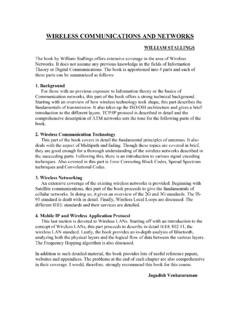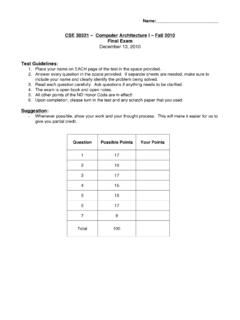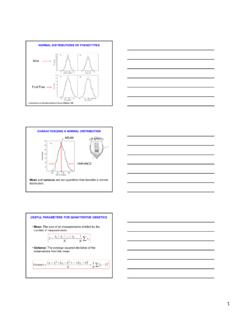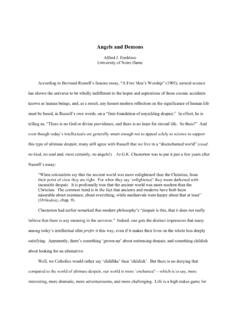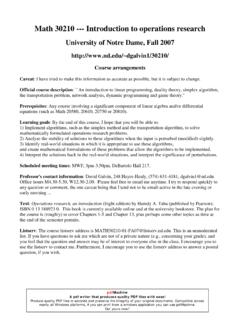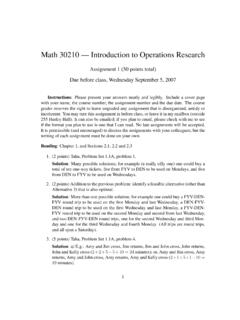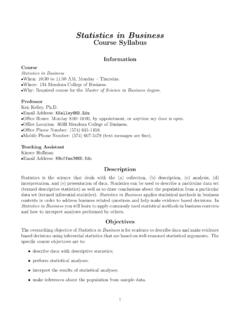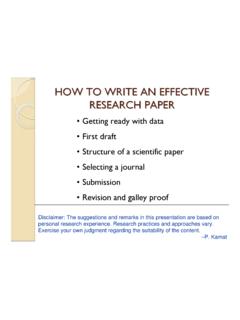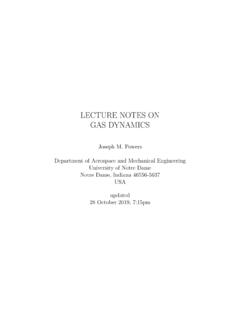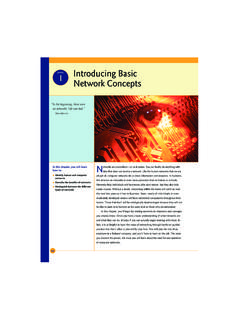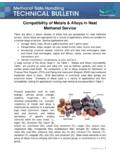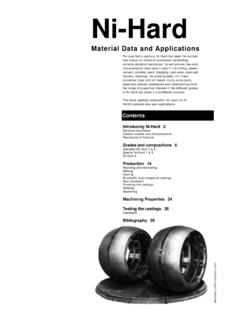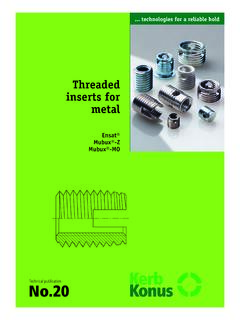Transcription of CHAPTER 11: METAL ALLOYS APPLICATIONS AND PROCESSING
1 ISSUES TO How are METAL ALLOYS classified and how are they used? What are some of the common fabrication techniques? How do properties vary throughout a piece of material that has been quenched, for example? How can properties be modified by post heat treatment? CHAPTER 11: METAL ALLOYS APPLICATIONS AND PROCESSING Classifications of METAL ALLOYS Fe 3 C cementite METAL ALLOYS Steels Ferrous Nonferrous Cast Irons Cu Al Mg Ti < wt%C 1600 1400 1200 1000 800 6 00 4 00 0 1 2 3 4 5 6 L g austenite g +L g +Fe 3 C a ferrite a +Fe 3 C L+Fe 3 C d (Fe) Carbon concentration, C Eutectic Eutectoid 727 C 1148 C T( C) Steels < Cast Irons tic Ferrous ALLOYS : iron is the prime constituent Ferrous ALLOYS are relatively inexpensive and extremely versatile Thus these ALLOYS are wide spread engineering materials ALLOYS that are so brittle that forming by deformation is not possible ordinary are cast ALLOYS that are amenable to mechanical deformation are termed wrought Heat-treatable - are ALLOYS whose mechanical strength can be improved by heat-treatment ( precipitation hardening or martensitic transformations).
2 Some definitions: Name: High Alloy Low carbon < Medium-carbon High carbon APPLICATIONS : auto struc. sheet bridges towers press. vessels crank shafts bolts hammers blades pistons gears wear APPLICATIONS wear APPLICATIONS drills saws dies high T APPLICATIONS turbines furnaces corrosion resistant Example (ASTM#): 1010 A633 1040 4340 1095 4190 304 Additions: none Cu,V,Ni,Mo none Cr, Ni,Mo none Cr, V,Mo,W Cr, Ni, Mo Hardenability 0 + + ++ ++ +++ 0 TS - 0 + ++ + ++ 0 EL + + 0 - - -- ++ increasing strength, cost, decreasing ductility Classification of Steels Low Alloy Plain Plain Plain High strength Heat treatable Tool Stainless 10-plane or C CAST IRON The cast irons are the ferrous ALLOYS with greater that wt. % carbon, but typically contain wt. % of C as well as other alloying elements, such as silicon (~3 ) which controls kinetics of carbide formation Fe 3 C cementite wt%C 1600 1400 1200 1000 6 00 4 00 0 1 2 3 4 5 6 L g austenite g +L g +Fe 3 C a +Fe 3 C L+Fe 3 C d (Fe) Carbon concentration, C Eutectic Eutectoid 727 C 1148 C T( C) wt%C These ALLOYS have relatively low melting points (1150-1300 C), do not formed undesirable surface films when poured, and undergo moderate shrinkage during solidification.
3 Thus can be easily melted and amenable to casting There are four general types of cast irons: 1. White iron has a characteristics white, crystalline fracture surface. Large amount of Fe3C are formed during casting , giving hard brittle material 2. Gray iron has a gray fracture surface with finely faced structure. A large Si content (2-3 wt. %) promotes C flakes precipitation rather than carbide 3. Ductile iron: small addition ( ) of Mg to gray iron changes the flake C microstructure to spheroidal that increases (by factor ~20) steel ductility 4. Malleable iron: traditional form of cast iron with reasonable ductility. First cast to white iron and then heat-treated to produce nodular graphite precipitates. Equilibrium and Metastable Phases Cementite (Fe3C) is a metastable phase and after long term treatment decompose to form a-ferrite and carbon: Fe3C 3Fe(S) + C(graphite) Slow cooling and addition of some elements ( Si) promote graphite formation Properties of cast irons are defined by the amount and microstructure of existing carbon phase.
4 Equilibrium iron-carbon phase diagram White and Malleable Cast Irons The low-silicon cast irons (< ), produced under rapid cooling conditions Microstructure: most of cementite Properties: extremely hard very but brittle White iron is an intermediate for the production of malleable iron White iron: light Fe3C regions surrounded by pearlite Malleable iron: dark graphite rosettes in a-Fe matrix Gray and Ductile Cast Irons The gray irons contain of Si Microstructure: flake shape graphite in ferrite matrix Properties: relatively weak and brittle in tension BUT very effective in damping vibrational energy an high resistive to wear!! Gray iron: Dark graphite flakes In a-Fe matrix Ductile iron: dark graphite nodules in a-Fe matrix Ductile (or Nodular) iron : small addition of Mg or/and Ce to the gray iron composition before casting Microstructure: Nodular or spherical-like graphite structure in pearlite or ferric matrix Properties: Significant increase in material ductility !
5 ! APPLICATIONS : valves, pump bodies, gears and other auto and machine components. RAPIDLY SOLIDIFIED FERROUS ALLOYS Eutectic compositions that permit cooling to a glass transition temperature at practically reachable quench rate (105 and 106 C /s) - rapidly solidified ALLOYS Boron, B, rather than carbon is a primary alloying element for amorphous ferrous ALLOYS Properties: (a) absence of grain boundaries easy magnetized materials (b) extremely fine structure exceptional strength and toughness Compositions (wt. %) B Si Cr Ni Mo P 20 10 28 6 10 6 40 6 14 Some Amorphous Ferrous ALLOYS Nonferrous ALLOYS Cu ALLOYS Brass : Zn is prime impurity (costume jewelry, coins, corrosion resistant) Bronze : Sn, Al, Si, Ni are prime impurities (bushings, landing gear) Cu-Be precipitation-hardened for strength Al ALLOYS -lower r : -Cu, Mg, Si, Mn, Zn additions -solid solutions or precipitation strengthened (structural aircraft parts & packaging) Mg ALLOYS -very low r : -ignites easily - aircraft, missiles Refractory metals -high melting T -Nb, Mo, W, Ta Noble metals -Ag, Au, Pt - oxidation/corrosion resistant Ti ALLOYS -lower r : vs for steel -reactive at high T -space APPLICATIONS NONFERROUS ALLOYS Cooper and its ALLOYS Cooper: soft and ductile.
6 Unlimited cold-work capacity, but difficult to machine. Cold-working and solid solution alloying Main types of Copper ALLOYS : Brasses: zinc (Zn) is main substitutional impurity; APPLICATIONS : cartridges, auto-radiator. Musical instruments, coins Bronzes: tin (Sn), aluminum (Al), Silicon (Si) and nickel (Ni); stronger than brasses with high degree of corrosion resistance Heat-treated (precipitation hardening) Cu- ALLOYS : beryllium coopers; relatively high strength, excellent electrical and corrosion properties BUT expensive; APPLICATIONS : jet aircraft landing gear bearing, surgical and dental instruments. Copper s advantages as primary METAL and recycled METAL , for brazed, long-life radiators and radiator parts for cars and trucks: Aluminum and its ALLOYS Low density (~ g/cm3), high ductility (even at room temperature), high electrical and thermal conductivity and resistance to corrosion BUT law melting point (~660 C) Main types of Aluminum ALLOYS : - Wrought ALLOYS - Cast ALLOYS - Others: Aluminum-Lithium ALLOYS APPLICATIONS .
7 Form food/chemical handling to aircraft structural parts Numerals Major Alloying Element(s) 1 XXX 2 XXX 3 XXX 4 XXX 5 XXX 6 XXX 7 XXX 8 XXX None (> %Al) Cu Mn Si Mg Mg an Si Zn Other elements ( Li) Typical alloying elements and alloy designation systems for Aluminum ALLOYS Temper Definition F As fabricated O Annealed H1 Strain-hardened only H2 Strain-hardened and partially annealed H3 Strain-hardened and stabilized T1 Cooled from elevated-T shaping and aged T2 Cooled from elevated-T shaping, cold-work, aged T3 Solution heat-treat., cold-work, naturally aged T4 Solution heat-treat and naturally aged T5 Cooled from elevated-T shaping, artificially aged T6 Solution heat-treat. and artificially aged T7 Solution heat-treat and stabilized T8 Solution heat-treat, cold-work, artificially aged T9 Solution heat-treat, artificially aged, cold-work Temper designation systems for Aluminum ALLOYS Magnesium and its ALLOYS Key Properties: Light weight Low density ( g/cm3 two thirds that of aluminium) Good high temperature mechanical properties Good to excellent corrosion resistance Very high strength-to density ratios (specific strength) In contrast with Al ALLOYS that have fcc structure with (12 ) slip systems and thus high ductility, hcp structure of Mg with only three slip systems leads to its brittleness.
8 APPLICATIONS : from tennis rockets to aircraft and missiles Example: Aerospace RZ5 (Zn - 5,0 SE - 1,7 Zr - 1,0 Mg remainder), MSR (AG - 3,0 SE - 2,5Zr - 1,0 Mg remainder) ALLOYS are widely used for aircraft engine and gearbox casings. Very large magnesium castings can be made, such as intermediate compressor casings for turbine engines. These include the Rolls Royce Tay casing in MSR, which weighs 130kg and the BMW Rolls Royce BR710 casing in RZ5. Other aerospace APPLICATIONS include auxiliary gearboxes (F16, Euro-fighter 2000, Tornado) in MSR or RZ5, generator housings (A320 Airbus, Tornado and Concorde in MSR) and canopies, generally in RZ5. Formula 1 Gearbox casting Titanium and its ALLOYS (1) Titanium and its ALLOYS have proven to be technically superior and cost-effective materials of construction for a wide variety of aerospace, industrial, marine and commercial APPLICATIONS .
9 The properties and characteristics of titanium which are important to design engineers in a broad spectrum of industries are: - Excellent Corrosion Resistance: Titanium is immune to corrosive attack by salt water or marine atmospheres. It also exhibits exceptional resistance to a broad range of acids, alkalis, natural waters and industrial chemicals. - Superior Erosion Resistance: Titanium offers superior resistance to erosion, cavitation or impingement attack. Titanium is at least twenty times more erosion resistant than the copper-nickel ALLOYS . - High Heat Transfer Efficiency: Under "in service" conditions, the heat transfer properties of titanium approximate those of admiralty brass and copper-nickel. Other ALLOYS Miscellaneous Nonferrous ALLOYS : - Nickel and its alloy: high corrosion resistant (Example: monel 65Ni/28Cu/7wt%Fe pumps valves in aggressive environment) - Lead, tin and their ALLOYS : soft, low recrystallization temperature, corrosion resistant ( APPLICATIONS : solders, x-ray shields, protecting coatings) The Refractory Metals: Nb ( C); Mo ( C); W ( C); Ta(3410 C) - Also: large elastic modulus, strength, hardness in wide range of temperatures - APPLICATIONS : The Super ALLOYS possess the superlative combination of properties - Examples: - APPLICATIONS : aircraft turbines.
10 Nuclear reactors, petrochemical equipment The Noble METAL ALLOYS : Ru(44), Rh (45), Pd (46), Ag (47), Os (75), Ir (77), Pt (78), Au (79) - expensive are notable in properties: soft, ductile, oxidation resistant - APPLICATIONS : jewelry (Ag, Au, Pt), catalyst (Pt, Pd, Ru), thermocouples (Pt, Ru), dental materials etc. Fabrication of Metals Fabrication methods chosen depend on: - properties of METAL - size and shape of final piece - cost AoAdforcedieblankforce Forging (wrenches, crankshafts) FORMING Drawing (rods, wire, tubing) often at elev. T Rolling (I-beams, rails) Extrusion (rods, tubing) tensile forceAoAddiedieMETAL FABRICATION METHODS-I Hot working: deformation at T > T(recrystallization) + less energy to deform + large repeatable deform. - surface oxidation: poor finish Cold working: deformation at T < T (recrystallization) + higher quality surface + better mechanical properties + closer dimension control - expensive and inconvenient Cold worked microstructures --generally are very anisotropic!
